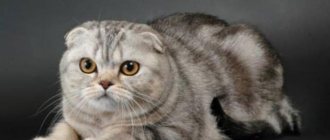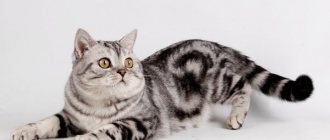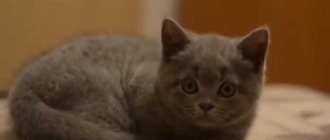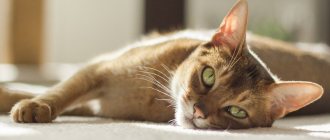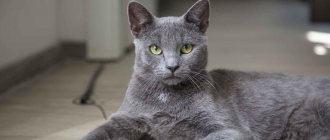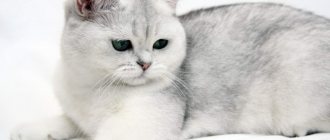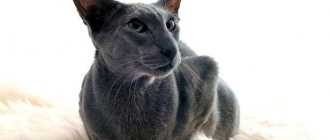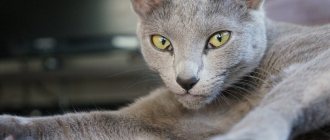Scottish cats have different colors. Scottish cats are famous because of their charming appearance and variety of colors. The color of kittens directly depends on certain genes. As a rule, these are two main shades, black and white.
Scottish Straight colors, for example, are gray with black stripes around the entire body. They are distributed as a percentage. That is, the animal’s fur is painted in two colors in different proportions. Its own gene is responsible for the dominance of one color or another.
Plain (solid)
The color of Scottish Fold cats is monochromatic and they should not have any other color. The fold-eared cat can be of the following colors: white and black, chocolate and lilac, blue and red, cream, fawn and cinnamon. The most popular color in the world among solid Scottish cats is blue. These are the majority of cats.
White
The white Scottish Straight cat can have different eyes, from blue and bright orange to rich amber and copper. Kittens of this variety remain white for the rest of their lives. If kittens have spots, then an adult cat remains white for the rest of its life.
Black
The Scottish Fold black cat is mostly bright in color. A couple of white hairs are acceptable, but if the cat has large red and brown patches, then it is not a purebred.
Black Scottish Fold cats should be bright black in color and their ears, like all fold-eared cats, should be pressed to the head, unlike straight-eared cats. A straight-eared black cat always has its ears erect.
Chocolate
The chocolate Scottish Fold looks impressive. The chocolate color is quite rare. Brown fold kittens should have a smooth, uniform coat of chocolate color. The dark brown coloring adds nobility to the cat.
A brown cat gets this color if he has chocolate, chocolate bicolor or chocolate color points in his pedigree. Chocolate Scottish kittens always delight their owners. They look very cool against a light background.
Lilac (lavender)
A lilac long-eared cat gets this color if he has either lilac color points or lilac in his pedigree. The lilac coloration goes well with orange, copper or amber colored eyes and a light brown nose. This color is also called coffee with milk.
Blue color (blue)
The Scots Blue can have a coat color of many shades of blue. Some cats may have a fur color closer to gray, and some closer to blue. Each hair must be saturated, then the coat will be perfectly blue.
Small pets have different patterns that disappear after a few months. Three months after birth, their eyes may be copper-colored.
Red (red)
Red Scots are a very rare breed. The ginger Scottish cat, like the ginger kitten, has a tail defect in the form of unevenly colored fur. In red-haired pets, red is sometimes more dominant than red.
These cats may have patterns on their foreheads and limbs, but this is not considered the norm. The Scots, unlike the British cat breed, can give birth to either a red fold-eared cat or a straight-eared cat.
Cream
The soft peach coat of a lighter color gives this cat an elegant appearance. At first glance, they are very similar to the red ones, but if you look closely, you can clearly see the difference. Cream hairs are lighter. Smooth patterns on the paws and tail are acceptable, but leopard spots are not acceptable.
Faun (deer)
The coat of kittens of this breed is a very interesting color. This shade should not be confused with lilac, which has a lilac tint. The paw pads and nose of these cats are beige-pink.
Cinnamon
At first this color can be confused with chocolate, but this is not so. This look is lighter and softer. Its nose and pads are beige or pink-brown.
Features and types of marbled color of lilac and tortoiseshell Scottish fold cats
Cat lovers often call the merle color a classic color, but this is not true. It is truly characteristic of many breeds and is found in pets on all continents.
The marbled color of Scottish Fold cats is presented in the form of a contrasting random pattern-ornament with characteristic spots on the sides or a butterfly figure on the back. The boundaries of the wide lines are slightly blurred. The colors of the background fur and pattern are different and never merge into one. But tiger stripes should still be considered traditional for cats, and marble is just one of their varieties.
The main characteristics of the merle color in Scottish Fold cats include:
- wide necklaces around the neck;
- along the entire length of the abdomen from the chest, colored “buttons” are located in two rows;
- Between the neck and tail there are three thick stripes on the fur;
- the tail is surrounded by rings.
Marbled Scottish Fold kittens are born with these signs. The pattern usually behaves steadily and does not change as the cat grows.
Felinologists identify 4 points according to which Scottish fold cats with a marbled color are subject to breeding culling and are not allowed to participate in exhibitions.
- Broken stripes that form spots of different sizes and configurations.
- Expressive contrast between the background and the pattern on the cat's fur.
- Discoloration (shading) of marble - colors are in close monochrome relationship and (or) in some places merge together.
- Blurred, unclear pattern.
The listed points often become a trick of scammers who assure the buyer that the Scottish Fold kitten will eventually bloom and the marble will return to its normal appearance. He may indeed change, but one should not hope for such an outcome. In order not to buy a “pig in a poke”, it is recommended to purchase marbled Scottish Folds no earlier than they reach the age of 3-4 months.
All color combinations are regulated by standards.
A lilac Scottish Fold marbled cat must meet the following requirements:
- lavender wool in pale tones occupies a background position;
- gray with a touch of gray hair (frost) color of the pattern;
- lavender nose;
- pink paw pads;
- eyes brown, copper, amber, honey;
- A lavender outline is visible around the nose and eyes.
It is noteworthy that lilac is one of the latest experimental colors and is therefore prohibited for many native cat breeds. But lilac Scottish Folds are not one of them and calmly display their beautiful coats at shows.
Marbled Scottish Fold cats in tortoiseshell color are representatives of a more traditional trend. Similar colors are typical for the vast majority of domestic cats and belong to the group of common ones. All “turtles” are naturally two-colored and differ only in the combination of the pattern on the main background. They can be black, blue, chocolate, sand, cinnamon and purple. In the latter case, the color takes the following form:
- gray coat on a lightened lavender background, and a peach or fawn (sand) pattern will cover the cream areas.
- the pupils are copper or amber.
- The nose mirror is pink and (or) lavender.
- paw pads are pink.
- the rim around the eyes and nose is lavender and (or) rich pink.
Important! In the Scottish Fold cat, the tortoiseshell color appears in spots only on the background areas of the coat, and each color corresponds to an individual shade of the pattern.
Bicolors
The coat color of these beautiful creatures has two colors, and a combination of white and any other shade is mandatory. Purebred bicolors must have a white belly, neck, chest, chin, limbs and, of course, muzzle.
join the discussion
Share with your friends
Cats are one of the cutest pets, and there are those who just look at you and make you smile, and you have an irresistible urge to look for them. These cats include the Scottish Fold breed, or otherwise the lilac Scottish Fold cat.
Description of the Scottish Fold cat
The Scottish Fold is considered a young breed. She has only been divorced for 50 years. The basic standard has been developed, but it is occasionally supplemented with some nuances.
The Scottish Fold cat is described in appearance as a British cat. These are completely two different breeds, so they should not be confused.
The Scottish breed is divided into two types:
- Scottish Fold (have floppy ears that are close to the head)
- Scottish Straight (have erect ears)
Scottish Straight is a Scottish breed with erect ears.
The Scottish Fold cat is a medium-sized breed. Females weigh from 3 to 5 kg, and males from 4 to 7 kg. Height at the withers reaches 28-32 centimeters. The approximate age to which Scottish Fold cats grow is 2-2.5 years. This question is purely individual and the maximum period is 3 years.
As for how long Scottish Folds live, the average lifespan is 12-16 years.
Scottish Fold breed standard
The head is round and massive. The button eyes are large and widely spaced. The cheek pouches are clearly visible. The chin is round, smoothly transitioning from a wide short nose.
The body is of medium size and massive. The width of the shoulder and pelvic girdles are equal. The paws are also of medium length, massive with well-defined muscles. The tail is of medium length and carrot-shaped (wide at the base and pointed towards the end).
In Scots, the ears are turned forward and are located at a great distance from each other. In kittens, the distance is 3-4 fingers; in adult cats, this is the width of the palm of your hand.
The most common reason for the disqualification of a Scottish Fold cat is incorrect placement and bending of the ears.
According to the number of folds formed, the ears of the Scottish Fold cat are divided into three types:
- Single (one bend, only the tip of the ear is lowered down)
- Double (the ear looks completely lowered, but there is a gap between the head and the auricle)
- Triple (the ear cartilage is pressed tightly to the head, no gap is formed, it fits into the overall circumference of the head). This type is considered the best of the breed.
Scots coat and color
The Scottish Fold cat has short hair with abundant undercoat. The coat is dense and pleasant to the touch. The color of a Scottish Fold cat can be very diverse (there are unacceptable variations in the CFA standard) and has a special coding.
According to the length of the coat, the Scottish breed is divided into:
- Shorthaired. Scottish Folds with this type of coat can be found more often. The length of the undercoat and guard are the same. The coat is very thick and plush to the touch.
- Longhair (Highland fold). Representatives of the breed with long hair are slightly less common. Some breeders are trying to develop a separate long-haired species. But the gene responsible for fur length can manifest itself in any Scottish kitten.
The cat named Matilda, the housekeeper of Freken Bock from the film “Baby and Carlson,” was a representative of the long-haired Scottish Fold.
Highland Fold - Scottish fold longhair cat
Unusual color
Cats of this breed are very cute and beautiful; their lilac color gives them a sophisticated aristocratic look. Even their nose and paw pads are lilac in color - they cannot mix and appear any color other than their own, in this case lilac. A different color is unacceptable not only on the animal’s fur, but also on other parts of the body (tail, ears, paws). You can meet representatives of this breed whose undercoat shade will be a little lighter, but still there will not be much difference from the main color.
A little genetics - how the marbled pattern is formed in a Scottish Fold cat
Decoding the cat genome is still in its infancy. Scientists figured out some elements quite quickly, but they are still very far from complete clarity.
Tortoiseshell and lilac Scottish folds are lucky in this sense. The basic hereditary rules have already been studied, the genes that are responsible for this color have been identified, and therefore selection does not face any serious problems.
The tabby trait (gene T) is responsible for the formation of a brindle pattern on a cat's coat: narrow necklace lines around the neck, thin stripes from top to bottom across the body, rings on the tail. The T gene is dominant over all others.
Next come the transformations of the T gene, which form other patterns on the animal’s coat:
- Allele Ta – Abyssinian color. It is recessive to pure T, but dominant to all subordinates.
- Combination TsTs – spots on the skin. Scientists suggest that breaker genes are responsible for such coloring (they have not yet been studied for sure). They influence the formation of tiger and marble patterns. But this theory still remains at the level of scientific hypotheses.
- In last place is the TbTb gene. In Scottish Folds and other cat breeds, it is responsible for the formation of the marbled pattern. Recessive to all variants without exception and therefore extremely capricious in breeding.
The next point is the agouti trait (gene A). It can take a dominant (A-) and recessive (aa, non-agouti) form. In the first case, the tabby pattern on the coat will appear, and in the second it will be hidden. Therefore, in lilac and tortoiseshell colors, agouti should always be present in a dominant state (A-).
Now about the flowers themselves. The genetic nature of color in Scottish Fold cats in the lilac and tortoiseshell groups differs.
First about purple cats. To understand all the relationships, you need to turn to the black (dominant B gene). In the bb allele it produces a chocolate shade.
The D gene in the recessive state dd changes the shades of the primary color and expands the palette. When dd is combined with black, it turns blue, red becomes cream, cinnamon cinnamon turns into sand fawn. And chocolate bb plus dd brightener together add up to a purple color. As a result, the genetic formula for the merle lilac will look like A-tbtbbbdd (dominant agouti first, then merle tabby, chocolate color and lightener).
The nature of the origin of tortoiseshell color in Scottish Fold cats is different. The A and T genes remain in place, the chocolate and lightening components (bbdd) are also present, but one additional element appears in the formula - the O (orange) gene.
We are talking about a gene that in the dominant state gives O-red (red) color, and in the recessive state it gives black. It is interesting because it is attached only to the X chromosome, which, in turn, affects the sex of the future Scottish kitten. In practical terms, it looks like this.
- set XX is a cat.
- combination XY is a cat.
Cats only have one X chromosome and therefore can be either ginger or not ginger. In cats, two dominant O- give a red color, two recessive O- give a black color, and in a set of O- the result is tortoiseshell. The lilac color of a tortoiseshell cat is written with the following formula - A-tbtbOobbdd. All its components duplicate the usual purple color with the addition of the “turtle” Oo allele.
This is interesting! Lilac Scottish “turtles” are always cats. Cats can acquire this color only in the case of a genetic mutation, which is expressed by an additional X chromosome (XXY). But such boys remain infertile and do not continue their family line.
Breed characteristics
These are amazing cats; two different temperaments can be combined in one animal. In childhood, these are energetic and playful kittens; in adulthood, they are imposing, quiet and calm cats. Representatives of Scottish Fold cats have a body of medium length, proportional and with soft curves, strong paws, wide pads, a long tail and always straight. The head has a round shape, cats have thick, pronounced cheeks. The ears are triangular and small, the tips are drooping, the eyes are large and round, their color may vary depending on the color of the coat. Mainly due to the head and muzzle, animals of this breed are easily recognizable.
Animals can weigh up to 6 kilograms, with an average height of 30 centimeters. Their average life expectancy is 15 years; if disease prevention is carried out and with a good pedigree, the cat can live up to 20 years.
Like any animal, they have their pros and cons, but each cat is individual. Their bad qualities include: vindictiveness, a tendency to obesity, since they do not have a sense of proportion and satiety in food, and they shed a lot.
Their good qualities are that representatives of this breed are smart and sociable animals. Their distinctive feature is independence and cleanliness, although they do not require special care.
And most importantly, in adulthood they are lazy cats; they do not need active games with their owners.
Author: felinologist Elena Shabaeva
If you ask the average person what color Scottish cats are, he will certainly answer that they are gray (the color among professionals is called blue). This is a common color of Scottish cats. But today the variety of colors is very large. Therefore, when asked what colors of Scottish cats there are, you must boldly answer: any! To get such a wide palette, Scots had to be crossed with other breeds. Today, interbreeding is not encouraged, because cats already have the necessary set of genes.
In this article we will answer the following questions: what color are Scottish kittens, what color are Scottish cats, what are the main genes that form the colors of Scottish Fold and Straight-eared cats (Scottish Straight, Scottish Fold, Highland Straight and Highland Fold).
Also in the article we will talk about how the color of Scottish kittens changes with age, and show photos of Scottish cats and kittens of almost all colors. Absolutely all colors cannot be presented within the framework of the publication, because... there are a lot of them, and the genes, combining in a bizarre way, still surprise breeders.
History of the Scottish Fold breed
The first mention of cats with floppy ears was recorded in Chinese sources in 1796. At the end of the 19th century, fold-eared cats were brought by sailors to Europe. The origins of the Scottish Fold breed can be traced back to 1961 with the cat Susie.
The fold-eared cat lived on a Scottish farm and was her owner's favorite. In 1963, residents of a nearby farm became interested in a cat with an unusual ear position. At the first opportunity, William and Mary Ross acquired a kitten from Susie and named him Snooks.
Snooks' offspring also had babies with floppy ears. Mary decided to cross her cat with a British cat. As a result of this crossing, kittens appeared. They were more reminiscent of the fold-eared Scots, as we are used to seeing them now.
The popularity of unusual Scottish cats grew. Genetic scientists also became interested in them. They found that the cause of this altered ear is a mutated gene. During the research, it was revealed that the presence of such a gene is unsafe for the animal. In addition to deformation of the ear cartilage, the gene can cause changes in other cartilages and fusion of vertebrae. But science does not stand still, and scientists have found a solution to this problem. The secret is to choose the right male and female. However, in England to this day cats with the mutant gene are not recognized.
To obtain healthy offspring, it is allowed to cross Scottish Folds only with Scottish Straights. Or crossing with a British cat is allowed.
In 1978, the Scottish Fold breed was officially registered and was allowed to participate in exhibitions.
COLORS OF SCOTTISH CATS and types of color
The colors of Scottish cats are divided into solid, tortoiseshell, smoke, tabby, bicolor, van, harlequin, shaded, chinchilla, point and ticked. This does not depend on the type of breed. Such colors can equally be found in Scottish folds, Scottish straights, highland folds and highland straights.
Solid (solid, monochromatic) colors
Solid color means that there are no inclusions of another color. The tone should be rich and even along the entire length of the hairs. If there are inclusions of a different color, this is either a different color or a defect, which reduces the price of the kitten and lowers the ratings at shows.
Solid colors come in blue (what lay people call grey), black (ebony), white, brown (chocolate), lilac, fawn (meaning “young deer” in English), cinnamon (cinnamon), red and cream.
Until recently, blue was considered a classic: such cats were the majority. However, today this is no longer the case. However, black, white, chocolate and red Scots are rarer creatures.
Two-color (bicolor)
Bicolor is the color of Scottish cats in which half the surface of the coat is white, and the other half is blue, cream, red or tabby. It is desirable that the drawings are symmetrical.
Point colors
The body of color point cats should have a basic light tone, and the face, ears, paws and tail should be darker. Hence the name: translated from English, the word “color” means “color”, and “point” means “point”.
Scottish point cats can be of several varieties: seal point, lilac point (white body with lilac markings), blue point (light body and light blue markings), chokelit point (white body and brown markings), cream point (light cream body and cream markings), tortoiseshell (tortoiseshell, which combines the base color markings with red or cream spots), tabby point (striped markings). There are other options for points.
Types of colors
Scottish Fold or Scottish Fold, a small animal weighing about 6 kg. The main feature is the presence of small ears, tilted forward and covering the auricles. Another characteristic feature is large, widely spaced eyes, very expressive. These cats meow strangely and creakingly. The breed was bred in the 60s of the last century.
To read: Feeding a German Shepherd puppy at different stages of growing up
Scottishfolds are characterized by both short plush and semi-long coats. Kittens will be born with straight ears. After a certain time, some kittens' ears become bent. The rest fall into the Scottish Strike category. The Scots have a strong, rounded torso. Short neck. The legs are of medium length, the tail is above average length. The colors of the eyes are very diverse - yellow, green, blue, brown, orange, gold. The nose is short and wide, with large whisker pads. There is a significant variety of colors of this breed.
White
All Scottish Folds are descended from white cats. They can have almost any coloring of their eyes, they even have different eyes - one eye is dark orange, the other is light blue. In white kittens up to one and a half years old, blue or black fur is acceptable on the head; after molting, it disappears.
White kittens are sometimes born deaf. When purchasing, it is worth checking by clapping your hands.
Cream
Very elegant color with a faint peach touch. Small leopard spots sometimes appear during molting. Eye coloring is dark orange or orange.
Black
In black Scots, no light inclusions are allowed. Only concentrated and deep color. Eye color is dark orange.
A cat's eyes are larger in relation to body size than those of most mammals.
Cinnamon color
The coloring is rare, so kittens are expensive. Various color gradations are allowed. The paw pads are brown and pink, the nose lobe is the same.
Brown (chocolate)
Any gradation of brown tones is allowed. Residual patterns after molting are not recognized. This color is considered unique. The nose and paw pads are light brown.
Lilac
The fur is beige. The eyes should be dark orange or orange in color.
Cats can see up to 60 meters away. Field of view is about 185, peripheral up to 285 degrees.
Red color
The uniqueness of the color of the animal depends on the color scheme and the clarity of the shades. In red Scottishfolds, the base of the hairs is light and gradually darkens towards the end. The tip is red.
Blue
Scottishfold blue has a wide variety of shades. From the lightest to the darkest, from light blue to blue. A solid color is required.
Bicolor
The coloring of bicolor cats allows two colors, one of which is white in combination with any other. The color distribution is approximately 30/70%. The classic bicolor, which is most valued, has the ideal of white paws, chest, neck and chin, and part of the muzzle. There is a kind of open necklace on the chest and neck. A small white triangle with a point on the forehead. The most common and beautiful bicolors are CREAM, BLUE and BLACK.
Point or Whiskas
A distinctive feature of this color is the light fur, like a background. She has darker shades in certain areas of her body. On the paws, ears, muzzle and tail area. The main thing here is the contrast of colors; extraneous patterns are not allowed, in particular on the stomach. The kittens are born light, but as they grow older the color becomes more pronounced. Only after a long period of time, up to 2 years, is the final coloration of the cat established.
To read: Recommendations for caring for a black fold-eared British cat, history of origin
Lilac (lilac)
Color code c33. The color of the body is slightly different from light, there is a slight purple coating, the spots of markings are gray with pink, dark but warm in tone. Bright blue eye color. The paw pads and nose pads are pink and gray.
The surface pattern of a cat's nose is unique, just like a person's fingerprints.
Blue
The standard color of this cat is “Siamese”, since Siamese cats have this coloring. Color code a33.
Cream
Color code e33. Light body, almost white. A color deposit under baked milk is allowed. The markings are cream, the eyes are light blue or dark blue. A small surviving drawing may be visible. Paw pads and nose pads are beige. If they are not very contrasting, then the eyes should simply shine.
A kitten's eye color may change over time.
Cream blue
The difference lies in the background fur. These are different variations of baked milk.
Chok-lit (chocolate)
Color code b33. Chocolate colored spots on the body. The body is beige.
Red
Color code d33. Unusual red color with warm tint marks. The body is white with a slight touch of gold or a faint orange, reddish tint. The paw and nose pads are pink and beige.
Strength
Dark brown patches of markings on a light cream body. The pads on the paws and nose are chocolate.
Torti
The main thing in coloring is that the markings of the spots repeat one of the main colors, spots of red or cream color.
- SIL CAKE (f33)
- BLUE CREAM CAKE (g33)
- CHAKLI CAKE (h33)
- LILAC CAKE (j33)
- CINNAMON CAKE (q33)
- FAUN CAKE (r33)
Tortoiseshells
Due to genetic characteristics, tortoiseshell colors are found exclusively in cats. This color is a combination of finely spotted coloring in equally distributed colors of red and black cells. The color should look proportional. The colors of the two cells should be evenly distributed. Brindle spots are prohibited. Eye color is dark orange or gold. Paw pads and nose pads are black, pink or black and pink. Recognized tortoiseshell colors include:
- BLACK-RED (SFSf)
- CHOCOLATE RED (SFSh)
- BLUE-CREAM (SFSg)
- LILOW-CREAM (SFSj)
- CINNAMON-RED (SFSq)
- FAUN-CREAM (SFSr)
Also, depending on the haze, a second letter is added - s.
- TORBILE - tortoiseshell tabby (tiger color). This is f22,23,24. Spot, stripe or marble.
- TORTI – tortoiseshell color point.
Black (ns)
A rare, special color, so it is in demand. The essence of color: white undercoat. When the cat moves, a light color appears. That's very beautiful. As a rule, the hairs on the sides are lighter and slightly silvery. There should be no extraneous inclusions or drawings. The paw pads and nose pads are black. Dark orange or orange eye color.
Chocolate
Compared to the classic brown color scheme, the color here looks lighter. “Silver” appears on the sides and on the ears. The paw pads and nose are chestnut.
To read: Agile and elegant dog Toy Terrier: description of the breed and behavior
Blue smoke
Very strict requirements for this color. All shades of blue are allowed. The undercoat is white, no residual patterns.
Tabby
This is the most contrasting and brightest color of the Scottishfold. The color of the coat can be varied, and the pattern is only spotted, brindle or marbled. There is also a ticked color - similar in appearance to a single color, but striped hairs appear on the back, and in the forehead area there is a characteristic “M”.
Spotted
The letter “M” in the forehead area, a necklace, circular stripes on the paws and tail, spots on the belly. The stripes are not continuous, but torn throughout the entire body area. Leopard coloring book.
Striped
It looks like a spotted one, but the stripes are clear, not broken, and contrasting. If the stripes widen or are interrupted with age, the color is no longer considered brindle. Eye color – orange, dark orange, green.
Marble
Two lines stretch longitudinally from head to tail. There are closed circles on the sides. Spots similar in description to butterflies on the back of the head. The letter “M” in the forehead area, rings in the form of closed lines-stripes on the neck. The merle color is present in kittens from birth.
Particolor (calico)
Unique coloring - tortoiseshell coloring on a light background.
Shaded (shaded)
An individual color feature is a white undercoat. The upper part of the hair is shaded with a dark color. Light color exclusively on the belly and sides. There should be no surviving drawings. Possible rings on the paws and the letter “M” in the forehead area. The main shaded colors are silver, gold and red.
Wang
This is a rather rare color. The main color of the fur is white. There are spots on the face and tail. Uneven stains and multiple stains on the body are acceptable.
Harlequin
Among the Scots this color is considered rare. The main white color has large spots, the tail is colored.
Rare colors of Scottish cats
Many readers ask what the rarest and most expensive colors of Scottish cats are. Today there are no problems finding any color, however, among breeders trying to get the maximum variety of colors of kittens from one cat, tortoiseshell cats are very much appreciated, because... they carry the genes of both the red and black series at once. Among ordinary people who are not involved in breeding, the so-called precious colors - gold and silver - are now in fashion. However, these colors can no longer be called rare, since such cats are becoming more and more popular due to their popularity.
And for those who are in search of what is the best color of Scottish cats, let’s say: this is the color that you like, because you live with this cat. You may become interested in cats whose color is as close to natural as possible, that is, spotted or tabby. Or maybe you will like red (ginger) cats, because... they please the eye and improve your mood with their appearance. Whatever color you choose, the main thing is that you like it.
Personality of the Scottish Fold cat
The Scottish Fold cat has a non-conflict character; she will make friends with everyone: both animals and people. The breed is distinguished by its intelligence and balance. Intellectuals by nature. Cats of this breed can be called safe for children: they are very patient and will not bite or scratch a child.
Scottish Folds are affectionate animals, but do not like to be cuddled. Representatives of this breed themselves come when they want to show their love for their owner. The Scottish cat's purr is unusual, it is loud and creaking. Meowing is also different from the usual. It seems that the animal does not know how to meow at all, but lop-eared representatives rarely do this.
The Scottish Fold cat very funny stands on its hind legs like a marmot. They do this in order to get a better look at the object of their curiosity. When the pet feels comfortable, it can allow itself to sleep on its back.
Scottish Folds tolerate travel well, although they are homebodies. They quickly get accustomed to the tray. And in general they respond well to training.
A bit of genetics
Many people are interested in learning how the colors of Scottish cats are formed. In Scottish cats, two genes predominate, responsible for black and red coat colors. Each of them can act as a dominant (suppressing weaker genes) and recessive (suppressed gene). And there is a third diluent gene, responsible for the saturation of the pigment. Combining in a certain order, these genes can give completely unimaginable coloring. If you are interested in the topic of the genetics of the colors of Scottish cats and what coloring results from crossing, come here. And we will continue.
The presence of one color or another in a Scottish kitten cannot always be determined in the first weeks of life. This is not the final shade yet, because the coloring becomes brighter and more pronounced only when the coat is replaced by an adult during the baby's molt. This happens around six months of age. But up to 2 years, the shade may still change slightly.
Scottish fold cat care and feeding
Caring for the Scottish breed does not require much effort on the part of the owner. Usually, pets are quite capable of maintaining themselves in order. It is necessary to comb your lop-eared pet at least once a week. It is better to use a rare comb.
You should periodically look into your cat's ears, remembering that this is a vulnerable place. Due to the anatomical features, the auricle is almost closed, creating a favorable environment for the development of bacteria and parasites. To prevent hearing diseases, you need to carry out hygienic cleaning 1-2 times a month. To do this, you should use lotions to clean your ears.
Water treatments and nail trimming should be carried out if necessary.
Brushing your teeth is a good prevention of oral diseases. It is worth using brushes and pastes intended for animals.
High-quality feeding is the key to good health for your pet, regardless of breed. It is recommended to feed Scottish Fold cats with ready-made diets. Scottish Fold cats are susceptible to metabolic diseases. It is important to feed them balanced food and always at the right rate, to avoid overfeeding.
The Scottish breed is suitable for living in an apartment. You can walk your lop-eared pets on the street, but it is better to accustom them to such walks from childhood.
Buy a Scottish Fold kitten
Despite the fact that the fold-eared breed is relatively young, it is very popular. In this regard, you can find many nurseries and breeders breeding this breed. When buying a Scottish fold kitten, you need to be vigilant, as you can easily suffer from the activities of scammers.
How to choose a fold-eared kitten
First you need to choose where to buy. Nurseries usually offer good kittens for sale. Children have vaccinations according to age and plus a package of documents. Purchasing a Scottish kitten from breeders is not the worst option. You can find responsible breeders who take care of their pets. Some, as well as nurseries, sell vaccinated kittens.
The optimal age for selling fold kittens is considered to be at least 2, and preferably 3 months. If you are offered to take a one-month-old kitten, this is wrong. At this age, the baby still needs maternal care. Also, at the age of 1 month, it is difficult to consider any congenital abnormalities. At 2-3 months this is much easier to do.
All newborn Scottish Fold kittens have straight ears. Therefore, to purchase a fold-eared kitten, you need to wait at least 3-4 weeks.
It is worth paying attention to the mobility of kittens and their playfulness. Scottish Fold kittens usually move around the room with ease and climb on objects. It would also be correct to assess the general health of the baby. Its fur should be clean, especially near natural openings. There should be no bloating. Pay attention to the tail: it should be flexible and mobile. Pay attention to whether the eyes of the Scottish Fold kitten you notice are watery.
Scottish kitten cost
The average price of a Scottish Fold kitten varies from 5,000 to 35,000 rubles ($100-500). The cost depends on the pedigree, whether the parents are titled or not, and how pronounced the breed characteristics are. A Scottish Fold kitten for exhibitions or breeding will cost more than a pet for pets.
Scottish catteries
Catteries for Scottish Fold or Scottish Fold kittens can be found in all major cities of the CIS countries.
Moscow
- www.cats-style.ru
- allegiancelove.ru
- Scottish.rf
Saint Petersburg
- alcasarcat.ru
- www.s-fold.ru
- lifejoycat.ru
Kyiv
- bastet.in.ua
Vitebsk
- real-cats.ru
Minsk
- ledy-koshka.com

